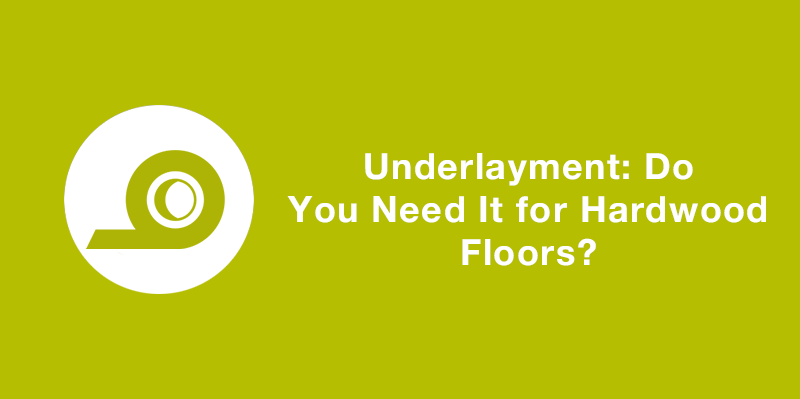Underlayment: Do You Need It for Hardwood Floors?

There are only a few things in life more satisfying than doing some renovations, taking the years off your beloved space, and seeing it become fresh and vibrant once again. Of course, taking down walls, getting new appliances, repainting the walls, and replacing fixtures all majorly contribute but let’s not forget that brand new hardwood floors can create just as much of an impact – if not more – than all these other modifications.
Of course, before you can ever even start laying down your specific flooring choice, though, you’ve got to make a choice about underlayment. Are there any benefits to it? Do you actually need this for your new floors? And what exactly is underlayment, anyways? We’re here to answer all those questions and tell you everything you need to know to get those perfect hardwoods you’ve been dreaming about.
What is Underlayment?
First thing’s first: what exactly is underlayment, anyways? Underlayment is a thin layer of material/ padding that is laid under your hardwood floors and is typically found in the form of foam, rubber, felt, or some similar material.
Underlayment is added for a variety of reasons. For many people, the biggest is for added protection from moisture, as the underlayment provides a buffer between your subfloors and expensive hardwoods — possibly saving your beautiful investment (and your mood) from getting ruined. That’s why it’s often used in climates with high humidity or in homes that make use of more moisture-emitting concrete subfloors.
Underlayment’s charms aren’t restricted to its protective abilities, although that is a big draw. Underlayment also makes hardwoods feel a little nicer underfoot, giving you a little, desperately needed cushioning, aiding in insulation for warmer feet in the winter, dulling the sounds of walking feet, and smoothing out pesky subfloor imperfections that could otherwise cause you problems.
Is Underlayment Actually Necessary?
So, there are plenty of pluses attached to opting for underlayment. But does this actually mean it’s necessary if you have hardwood floors? Do you genuinely need it, or is it an additional cost you can feel decent about skipping? The short answer is it depends.
Underlayment honestly isn’t the be-all, end-all for fantastic flooring. The best thing you can do to secure beautiful, long-lasting floors that’ll look great for years to come is simply to choose the right hardwood in the first place. There are seemingly a million options out there, each in different stains/colors, thicknesses, hardnesses, grains, and other qualities. That means not every kind is going to be ideal for every situation or lifestyle.
Some will naturally be a better fit for you than others. For example, if your family is incredibly active, has pets, and tends to be very rough on your surroundings, you can’t get much better than some sort of hickory hardwood since it’s the heartiest kind you’ll find out there. It’ll be able to withstand even some of the rowdiest kids and big dogs you can throw at it, whereas something more delicate like pine would probably get torn up pretty fast.
However, even with all this said, underlayment can only bring good things your way. There’s practically never a situation where opting for padding below your floors is a negative. Thus, while it might technically not be a strictly “necessary” additional expense to finances and time, it’s one we wholeheartedly recommend if you have the resources available.
Why? Because at the end of the day, it will only improve your floor’s stability, reduce the noise that inevitably happens when you opt for real hardwood, make walking less of a strain for adults, kids, and pets alike, and potentially lengthen your hardwood’s lifespan by protecting it from dampness and providing additional support.
You’ll then get more from your investment and guarantee you’re not left skimming the home store catalogs or Menard’s shelves for replacements sooner rather than later. And while it might not be super noticeable, an underlayment will make your daily experience cleaning, cooking, chasing the kids around, and generally spending time wandering around your home a touch more comfortable.
Underlayment Material Options
The choice to use underlayment or not is far from straightforward for most folks. The reality is that renovations of any kind are remarkably costly. Anywhere you can save a few bucks is always appreciated, and skipping out on the material between your hardwood and subfloors is an attractive proposition when you see how much it could reduce your costs.
But suppose you’ve recognized all the benefits eating the additional price can bring you and decide to install underlayment. In that case, you still have a decision to make: the kind of underlayment material you want to use. There are primarily four main types you’ll want to consider, each with plenty of pros and pluses to their names. These include:
- Felt – Unless you’re super crafty, you probably haven’t used felt for much of anything in years. It turns out, though, it makes for wonderful underlayment. It’s indeed the most popular kind used with hardwood, good for combatting low levels of dampness and noise. It’s not the cushiest or springiest on the market, but thicker layers of felt can up the comfy quotient pretty well. For those of you worried about environmental concerns, felt is also the better choice since it’s made from recycled material. Our QuietWalk Plus underlayment is such a popular choice because it does well in all categories and works great with hardwood flooring.
- Rubber – Need something a little more heavy-duty on the sound reduction and insulation? Rubber is going to be better for you, offering strong protection against nearly everything while remaining easy to install. Do be warned, however. Most rubber underlayments will have you forking out more significant bills. However, we have managed to create reasonably priced rubber underlayment with all the same benefits called SoundBuffer.
- Foam – Foam is used in so many products out there. It shouldn’t be a surprise that it’s also a popular underlayment material. You might be surprised at how well it works, though. Cheap, easy to install, suitable for cushioning, and even better for noise absorption. The only downfall to foam is its durability. Many foam underlayments tend to rip on installation. Since foam underlayment is made from tiny trapped air bubbles, the air bubbles can be pressed out over time, causing them to lose benefits over time.
- Cork – Aren’t convinced that the other three options here are for you? Cork functions as a solid alternative, albeit one that’s significantly less popular than its competition. It is mostly unpopular because it tends to be more expensive than even rubber. Sound absorption is right on par with foam, and it performs even better at giving floors extra stability thanks to its mixture of firmness and flexibility. Bonus, cork is a sustainable, renewable resource and has anti-microbial properties. Not too shabby for the underdog, huh?
Join Our Newsletter
You are about to install your new flooring. As you lay the first plank you realize that

